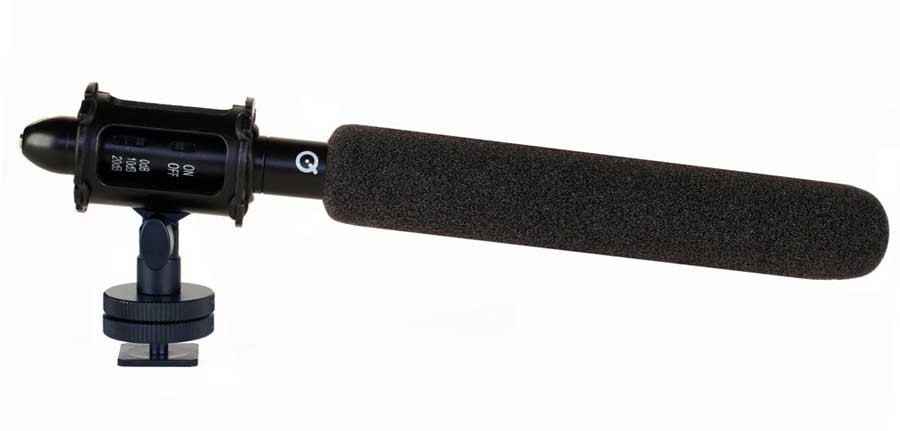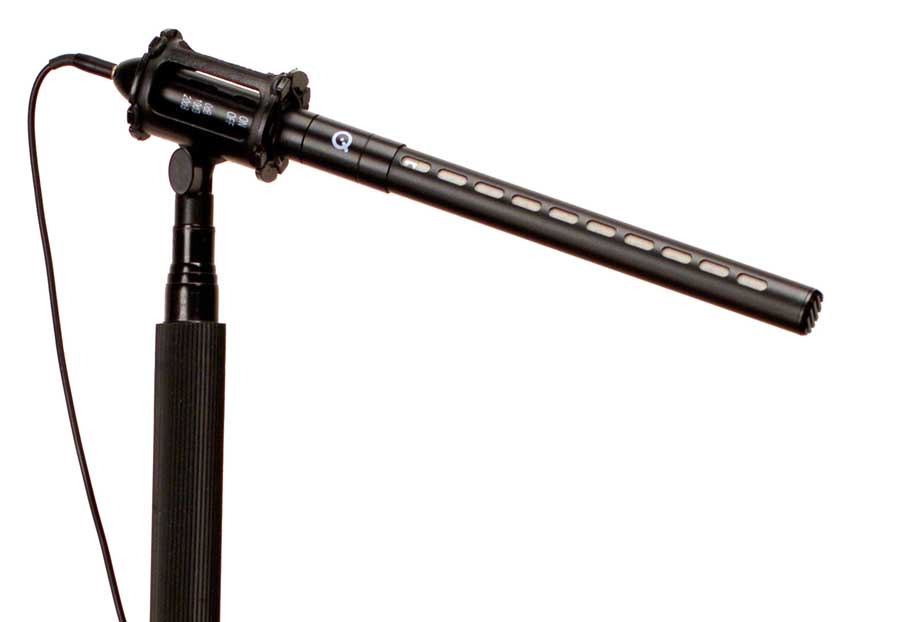



| Review: Que Audio Sniper PRO Kit for the Zoom H4n & DSLRs |
May, 2013

Que Audio Sniper PRO Kit for the Zoom H4n & DSLRs
Que Audio - $499.00
Review by Steve Douglas
A couple of years ago I reviewed the then new Zoom H4n handheld field recorder.
To this day, I still use the H4n on a regular basis for interviews when I am out of the country and for quick and easy recordings of band rehearsals and club gigs. It is well made, easy to hold in one's hand or placed on top of most anything available. Usually I use the on-board mics for simple recordings, but the H4n also allows for the use of XLR mics and 4 channel recordings that would Produce an even higher quality recording.
The only issue with using the XLR mic inputs on the H4n are the microphone cords you then have dragging down behind you as you move around, or having a subject tripping over them possibly causing damage to both the mics as well as the H4n itself.
When filming with a DSLR or any camcorder one runs into another issue; the built in mics never produce an audio quality that is very usable. Additionally, I found when using a Canon 7D that the shotgun mic I was using was simply too big to use on the camera's hot shoe making it necessary to attach it to another stand. When you are shooting in a run and gun style, having to drag along extra stands is not very practical.
Que Audio has come up with a mighty feasible solution to these problems in the form of a highly useful little kit to be used with the Zoom H4n or DSLRs. Additionally, in my opinion, it could just as easily be used with a great number of different handheld field recorders in its genre.
Let's start with the basics; what comes with the Sniper PRO Kit is just about all you really could want whether you are using it with a DSLR, the H4n or other field recorder. Included in the nicely made leatherette zippered case is a stainless steel mini boom pole, rubberized at the handle for easy gripping, that can telescope from 13" to a full 57", a metal base that is 5" across, a Q Mini Shotgun PRO microphone with its own shock mount and foam windscreen, a fluffy wind muff, extra o-rings for the included shock mount, 10 extra microphone batteries, an 11.8" coiled cable and a 6.5 foot straight cable for use with the H4n and boom pole. The leatherette case contains a fairly rigid foam insert in which each piece may be securely placed when not in use and provides extra protection for the microphone, boom pole and other attachments.

Most everything you need is included at a very reasonable price.
The Q Mini Shotgun PRO microphone, at 7.5" in length initially did not raise my expectations for its potential audio quality. It is well made and professional in appearance and, I am pleased to say, this time, my gut feeling was wrong. The microphone connected to the supplied XLR adaptor and then inserted into the XLR inputs of the H4n produced a very fine and listenable audio track using the H4n's 4 track audio recording mode. I made several test recordings comparing the Q Mini Shotgun PRO to an AKG 1000E microphone I use in band situations, an Azden SGM-1X Shotgun, as well as to the H4n's on board mics. All replays of the audio were done through a set of Focal Speakers.
The Q Mini Shotgun PRO's audio was, without hyperbole, excellent and produced a natural and easy replay of both my voice as well as instrumentation. There was a nice bottom end to the recording and mid- tones had a natural quality for voice reproduction. The Q Mini PRO certainly held its own against my other microphones and clearly produced a better recording than the H4n's on board mics which, by themselves, are not of bad quality at all. The frequency response ranges from a deep 50Hz to 16KHz with a sensitivity of -48dB. I found this little mini shotgun to be very resistant to ambient background noises; its hypercardioid polar pattern did an excellent job of minimizing unwanted audio from behind the mic from being recorded. With 3 recording gain options of 0db, +10 or +20 dB the sensitivity increases audibly. There is a warning included in the case that says that, when using the microphone's +10 or +20dB settings, the battery life will shorten significantly, but I didn't test this out to anywhere near full drainage of the battery.

Set to the default switch of 0dB, the battery is listed as having a life of approximately 100 hours of continuous use. The microphone uses 2 AG4 1.5 button cells. When I unscrewed the rear of the microphone to access the batteries, I should have been more careful as they both dropped out onto the floor and rolled under a drum kit. After finally retrieving them, I found it difficult to drop them back in properly as they drop into the tube of the mic itself. I also was not sure whether the positive or negative side went in first. I missed the easy to see icon on the mic showing the proper way to install the batteries. My fault and this was probably just a 'new user' issue which won't be repeated again. Never the less, when switching out batteries do so over a table, bench or paper towel, not standing up in a darkened room during a band engagement.
The supplied cables use a very small threaded connection for the microphone and adapters but were a perfect length for the boom pole itself when using the Q Mini PRO connected to an H4n. The coiled cable was just fine for use with the DSLR as well.

The light weight of the fully extended pole and microphone could be held comfortably without duress for long periods of time as my wife would testify when I had her holding it for a rehearsal. The rubberized hand grip was a great touch and helped keep the pole steady. There is an optional attachment, the QAD4 T-Bar, that will secure the H4n to the boom pole. It utilizes three 1/4" 20 thread male connectors in a T shape, with a female 1/4" 20 thread female connector at the bottom, which is also great for a myriad of run and gun applications. It lists for $19.99 and, if you are using the H4n or similar field recorder, I strongly suggest that you include this option in your purchase. It screws directly into the rear of the H4n and the bottom of the boom pole making the Que Audio PRO Kit an 'all in one' ready to go audio capture system. In my opinion, this one small attachment should be included as part of the entire kit, but seeing that it is not, you will certainly want to add this piece to your order.
The supplied base for the boom pole is sturdy and well made and, if used and left alone, would provide stability for microphone just fine while recording. However, because the base is only 5" across, anyone accidentally bumping into it would probably knock it over. This did occur in use when the pole was fully extended, but fortunately my friend caught it before it fell completely and no damage was done.

Not showing its full extension of almost 5 feet, when placed upon a table
or somewhere out of bumping range, the stand Provided a very stable support.
The shock mount that comes with the kit held the microphone quite securely. It is made of plastic and I have questions regarding its long term durability. Never the less, all parts can be ordered from Q Audio whenever needed.

Be sure to read the supplied 'User's Guide' which, initially, I ignored thinking it was just a catalogue of optional parts. It actually contains many good suggestions for uses with different DSLRs and the proper way to change out the batteries, which I found out the hard way. Additionally, I should commend Que Audio for their many video tutorials on run and gun filming and recording, the proper use of shotguns mics, working with talent, changing the batteries (wish I had watched this beforehand) using the wind muff and several others. On Que Audio's main page just click on the channel Q menu selection which will bring you to these and several more video demos. They are all brief but clear and well done.
As most of my filming and recording is done in the field; weight of equipment when flying to other countries is always a concern, but the Que Audio Sniper PRO kit weighs very little and can easily be packed into either a checked bag or as a carry on. The carry case provides enough protection that I would have no qualms about putting it in a checked bag.
My bottom line is that, for those wanting the significantly increased quality of an external microphone rather than relying upon a camera's built in audio, and for those like myself using field audio recorders like the H4n, the Que Audio Sniper PRO Kit is definitely one kit that will raise the game. I've come across nothing better of its kind.
 Steve Douglas is a certified Apple Pro for Final Cut Pro 7 and underwater videographer. A winner of the 1999 Pacific Coast Underwater Film Competition, 2003 IVIE competition, 2004 Los Angeles Underwater Photographic competition, and the prestigious 2005 International Beneath the Sea Film Competition, where he also won the Stan Waterman Award for Excellence in Underwater Videography and 'Diver of the Year', Steve was a safety diver on the feature film "The Deep Blue Sea", contributed footage to the Seaworld Park's Atlantis Production, and Productions for National Geographic and the History channels. Steve was a feature writer for Asian Diver Magazine and is one of the founding organizers of the San Diego UnderSea Film Exhibition. He is available for both private and group seminars for Final Cut Pro and leads underwater filming expeditions and African safaris with upcoming excursions to the Palau. Feel free to contact him if you are interested in joining Steve on any of these exciting trips.
Steve Douglas is a certified Apple Pro for Final Cut Pro 7 and underwater videographer. A winner of the 1999 Pacific Coast Underwater Film Competition, 2003 IVIE competition, 2004 Los Angeles Underwater Photographic competition, and the prestigious 2005 International Beneath the Sea Film Competition, where he also won the Stan Waterman Award for Excellence in Underwater Videography and 'Diver of the Year', Steve was a safety diver on the feature film "The Deep Blue Sea", contributed footage to the Seaworld Park's Atlantis Production, and Productions for National Geographic and the History channels. Steve was a feature writer for Asian Diver Magazine and is one of the founding organizers of the San Diego UnderSea Film Exhibition. He is available for both private and group seminars for Final Cut Pro and leads underwater filming expeditions and African safaris with upcoming excursions to the Palau. Feel free to contact him if you are interested in joining Steve on any of these exciting trips.
This article first appeared on www.kenstone.net and is reprinted here with permission.
All screen captures and textual references are the property and trademark of their creators/owners/publishers.